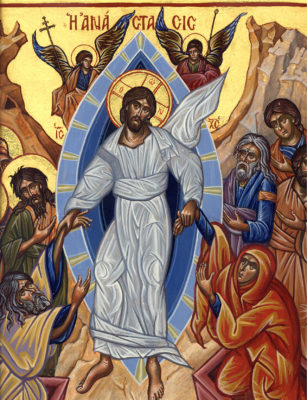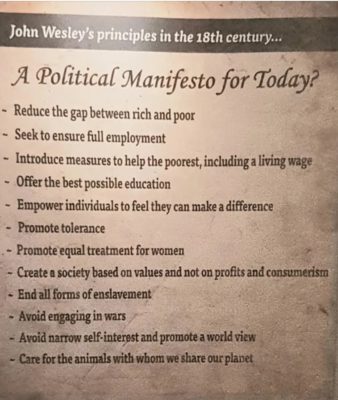“Living Stones: Building a New World” by Brenda Seat

May 10, 2020
Fifth Sunday of Easter
We are in the midst of a pandemic. . . . Just sit with that for a moment.
Every morning I wake up and in those first few seconds, sometimes even minutes, I think about the day ahead, the things I need to do, and then all of a sudden this realization will flood over me. We are living in a different time and in a different reality.
Recently Laurie Garrett, a Pulitzer prize winning journalist, a Harvard Fellow and author of the book The Coming Plague, has been making the rounds on the news and in print media. Often called the “prophet” or “Cassandra” of this epidemic, she foretold what is happening right now . . . in 1994. In a recent interview[1] when asked what she sees coming next, she said that her best case scenario – to find a vaccine, to ramp up production and then vaccinate the entire world – would take 36 months. Thirty-six months if nothing goes wrong.
In the meantime, she predicts that the virus:
is going to go in waves. . . . It won’t be a tsunami that comes across America all at once and then retreats all at once. It will be micro-waves that shoot up in Des Moines and then in New Orleans and then in Houston and so on, and it’s going to affect how people think about all kinds of things. They’ll reevaluate the importance of travel. They’ll reassess their use of mass transit. They’ll revisit the need for face to face . . . meetings.
So what about going back to normal? Will that happen? Garrett says:
This is history right in front of us. . . . Did we go ‘back to normal’ after 9/11? No. We created a whole new normal. We securitized the United States. We turned into an antiterror state. And it affected everything. We . . . couldn’t get on airplanes the same way ever again. That is what is going to happen with this.
Thirty-six months. Three years of living into this new reality. So how are we going to spend the time that we have? What do we want to think about and what are our goals in this time of Covid-19?
Sonya Renee Taylor, a poet and author, says:
We will not go back to normal.
Normal never was. Our pre-corona
existence was not normal other than
we normalized greed, inequity,
exhaustion, depletion, extraction,
disconnection confusion, rage,
hoarding, hate and lack. We should
not long to return, my friends. We
are being a given an opportunity to
stitch a new garment. One that fits
all of humanity and nature.[2]
We are in the season of Easter. I have to remind myself of that sometimes, because I feel like I am still back in Advent, waiting; Waiting for this to all be over. We have passed through Christmas, we have passed through Lent, and now we are in Easter celebrating resurrection. Our theme is Witnesses to Hope and our reflections says “there is no hell from which resurrection is impossible.”
I am glad in moments like these to know that it is not my faith alone on which the church is built. Because although I helped choose both theme and reflection I still struggle on a daily basis to really truly believe, deep down, to the bedrock of my being, that this is true.
Like Philip, I still need proof positive. Jesus tells the disciples, “I am the way, the truth and the life, through me you will find God.” And Philip responds, “Show us who God is and then we will be satisfied.” In other words, I need an address, Jesus, I need more than just your words and your life to show me who God is. And that is so me! I just want a little more help here. I need sign posts and directions and labels and surety.
I need a lot of help, believing.
When Keith and I first came to Seekers many years ago now, we were a bit fragile. We had lost a child, we had a small baby, both our parents lived in Japan and we had moved away from Keith’s extended family to come to DC. We were ungrounded.
Spiritually, we were still tied up in the knots of a fundamentalist Christianity we no longer believed, but were unable to find a way out of that labyrinth of certainty and dogma which flew in the face of science, reality and even modern theological thought. We were still caught in the hands of an angry God, without an exit ramp.
What I came to realize is that at Seekers I could put all that down. No one pointed fingers at me when I revealed my doubts. They actually applauded! They pushed me to think beyond these limited ideas that I had and made me think deeper, broader, and more completely.
I have been attending this apprenticeship in the path of Jesus/theological seminary since 1987 and I am still learning, still finding God.
In the Epistle reading for today it talks about growing into our salvation, to become living stones, rejected by mortals yet chosen and precious in God’s sight, and to let ourselves be built into spiritual houses, to be a holy priesthood.
Whenever I read this passage before I was always thinking of the giant chiseled granite rocks that form the walls and moats around the Imperial Palace in Tokyo, Japan. Large, immovable, built and chiseled to fit together precisely, like a puzzle. They are massive and unyielding; they are monumental and intimidating.
But this time when I read this I thought about Nehemiah, who began rebuilding the walls of Jerusalem out of the rubble, the fallen pieces, the broken, the remnants and the rejects.
The Epistle writer says “The stone that the builders rejected has become the very head of the corner, the cornerstone.” So if even Jesus can be a rejected stone, how much more likely are we to be stones that are flawed, rejected, and imperfect and not some pristine, made to order, finely chiseled stone.
Somehow the idea that we are building a community of faith from the rubble, that we are using stones that were used in other edifices of faith, that we can create something new, strong and resilient from something that was broken and rejected is empowering.
And this is what resurrection is.
I am not sure when I finally realized that the resurrection stories all show Jesus with wounds. He was not triumphal perfection! He still showed the trauma of his ordeal in his resurrected body. He was broken and yet resurrected and whole all at once. Just as we, this body of Christ are broken and whole all at once. We, too, are creating a living edifice; but the wounds show, the brokenness shows, and the places of crumbly, inadequate faith show, too.
But our strengths are there as well. The commitment to follow Jesus; the strength of following our call; the wisdom of mission groups; the courage of our love for each other and for our world and our planet; the consistency of showing up and to be there for each other; and the careful listening that allows each of us to articulate into words the message we are each hearing from God.
We are living stones rejected by mortals, yet chosen and precious in God’s sight.
The beauty of this image is that it doesn’t depend on one of us. We are in this together. My faith may be at low ebb but someone else is strong. I may not have vision now but someone else has that vision. My commitment may flag but someone else will carry me over the finish line.
In the fundamentalist vision of the world it was all me or nothing. It was all about my personal salvation, my relationship with Christ. And for me that was its fatal flaw. No one can sustain that, not even Jesus, whose night in Gethsemane was full of anguish at the thought of what was ahead. When I came to Seekers it finally clicked for me.
We are recreating; we are reimagining; we are reconstructing ourselves into the image of Christ. Since no one person can be that, we are doing it together, so that our strengths shine through and our weaknesses are supported, cared for and mended.
I can never be the Body of Christ, but WE? WE have a chance. WE might be able to pull it off. WE can become – are continually becoming – the body of Christ, and that is the power of resurrection.
OK, so we are living stones, the Body of Christ, God’s own people as the Epistle writer tells us. He goes on to say that we are chosen so that we can proclaim the mighty acts of God, who called us from darkness into the light.
As Sonya Renee Taylor, the poet I quoted earlier, points out so vividly, our world has lost its way. Normal is not something we want to return to. It is not God’s vision for this world.
In Bristol, England there is a museum in a building built by John Wesley in 1793. In order to stimulate conversation and discussion the curators of the museum created what they call a “Political Manifesto for Today” based on the teachings of John Wesley. Let me share it with you:
Reduce the gap between rich and poor
Seek to ensure full employment
Introduce measures to help the poorest, including a living wage
Offer the best possible education
Empower individuals to feel they can make a difference
Promote tolerance
Promote equal treatment for women
Create a society based on values and not on profits and consumerism
End all forms of enslavement
Avoid engaging in wars
Avoid narrow self-interest and promote a world view
Care for the animals with whom we share our planet. [3]
Is this enough? Is there more? What else would we want to include? Could we here at Seekers create our own Manifesto for Bringing into Being the Kingdom of God?
We are in the midst of a pandemic.
Out of the broken pieces of the world that remain after the virus passes or we have a vaccine, how will we contribute to rebuilding the world?
Do we really believe that there is no hell from which resurrection is impossible? Are we Witnesses to that Hope?
Let’s find out!
And thank goodness we are all in this together!
Amen.
[1] https://www.nytimes.com/2020/05/02/opinion/sunday/coronavirus-prediction-laurie-garrett.html
[2] https://images.app.goo.gl/PUampjz2NWvRxJyq5
[3] https://www.newroombristol.org.uk/john-wesleys-principles/
